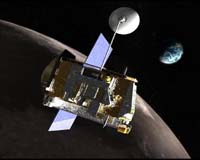 |
Pasadena CA (SPX) Jun 19, 2009 A new lunar topography map with the highest resolution of the moon's rugged south polar region provides new information on some of our natural satellite's darkest inhabitants - permanently shadowed craters. The map was created by scientists at NASA's Jet Propulsion Laboratory, Pasadena, Calif., who collected the data using the Deep Space Network's Goldstone Solar System Radar located in California's Mojave Desert. The map will help Lunar Crater Observation and Sensing Satellite (LCROSS) mission planners as they target for an encounter with a permanently dark crater near the lunar South Pole. "Since the beginning of time, these lunar craters have been invisible to humanity," said Barbara Wilson, a scientist at NASA's Jet Propulsion Laboratory in Pasadena, Calif., and manager of the study. "Now we can see detailed topography inside these craters down to 40 meters [132 feet] per pixel, with height accuracy of better than 5 meters [16 feet]." Scientists targeted the moon's south polar region using Goldstone's 70-meter (230-foot) radar dish. The antenna, three-quarters the size of a football field, sent a 500-kilowatt-strong, 90-minute-long radar stream 373,046 kilometers (231,800 miles) to the moon. Signals were reflected back from the rough-hewn lunar terrain and detected by two of Goldstone's 34-meter (112-foot) antennas on Earth. The roundtrip time, from the antenna to the moon and back, was about two-and-a-half seconds. The scientists compared their data with laser altimeter data recently released by the Japanese Aerospace Exploration Agency's Kaguya mission to position and orient the radar images and maps. The new map provides contiguous topographic detail over a region approximately 500 kilometers (311 miles) by 400 kilometers (249 miles). Funding for the program was provided by NASA's Exploration Systems Mission Directorate. JPL manages the Goldstone Solar System Radar and the Deep Space Network for NASA. JPL is managed for NASA by the California Institute of Technology in Pasadena. Share This Article With Planet Earth
Related Links Goldstone Solar System Radar and Deep Space Network Mars News and Information at MarsDaily.com Lunar Dreams and more
 Professor Prepares For America's Return To The Moon
Professor Prepares For America's Return To The MoonTempe AZ (SPX) Jun 19, 2009 The Interdisciplinary A building on the Tempe campus looks rather average from the outside. There isn't anything that hints at the excitement, talent and innovation hidden behind its nondescript doors, and there is certainly no indication that the first steps of a great journey are taking place inside. For nearly two years, professor Mark Robinson and his team have called this building ... read more |
|
| The content herein, unless otherwise known to be public domain, are Copyright 1995-2009 - SpaceDaily. AFP and UPI Wire Stories are copyright Agence France-Presse and United Press International. ESA Portal Reports are copyright European Space Agency. All NASA sourced material is public domain. Additional copyrights may apply in whole or part to other bona fide parties. Advertising does not imply endorsement,agreement or approval of any opinions, statements or information provided by SpaceDaily on any Web page published or hosted by SpaceDaily. Privacy Statement |